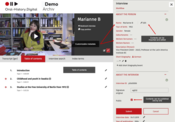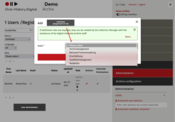Want to share and publish your interview archive?
Oral-History.Digital offers archive owners a comprehensive management and curation platform. The steps involved are explained on this page. Help on how to develop your interview collection can be found here.
In Oral-History.Digital, you can upload audio and video files, edit transcripts, add tables of contents, keywords, and comments, and supplement them with photos and accompanying documents. Tools, metadata standards, and guidelines are available to assist you. Within your team, you can assign different roles for cataloging work, even in an interview project that is currently in progress.
You can make your interviews available via a customizable archive page, which you can incorporate into your own website, and personally activate interested researchers to use your archive. If you wish to do so, you can also only upload metadata, without uploading the corresponding interviews.
To become part of Oral-History.Digital, send us information about your interview archive using the contact form. Further details can be found under “Documents”.
The team will then create a page for your archive in the development environment of Oral-History.Digital, which you will manage yourself. Once your archive has been created, your interviews will be findable in Oral-History.Digital's cross-archive search with basic metadata (e.g., interview year, media type, abbreviated last name, etc.), which can be anonymized if necessary.
You can als use Oral-History.Digital for ongoing interview projects. Even after conducting your first interview, you can upload it to the platform, index it, and evaluate it collaboratively.
If required, your interviews can also be archived in high quality for the long term. For long-term archiving of your media files (instead of the web-optimized versions in Oral-History.Digital), you can send your interviews via Oral-History.Digital to the CLARIN Center BAS at LMU Munich. To do so, you must sign a separate agreement. The BAS charges a one-time fee for this service. Details can be found under “Documents”.
You can consult the instructions in the help-wiki for all working steps in the archive. Additional advice is available during regular office hours (every other Wednesday), and the team can also be reached by email or phone.
The Oral-History.Digital software is available as open source at https://github.com/oral-history-digital as an operational prototype. We look forward to hearing from you.









